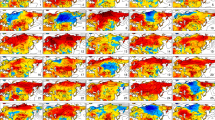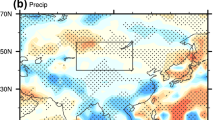Abstract
The present study investigated seasonal and spatial characteristics of the trends in surface air temperature (SAT) over Central Asia during 1979–2018 and the relative contributions of dynamic and thermodynamic effects using a dynamical adjustment methodology. Regional averaged total SAT shows the largest rising rate in spring and its trend is not obvious in winter. The thermodynamically effect induces a widespread warming trend in most of Central Asia in all the four seasons. The dynamically induced SAT trends exhibit obvious seasonal and regional differences. Both dynamic and thermodynamic effects play a crucial role in the total SAT increasing trend in spring, the thermodynamic effect is predominantly responsible for SAT warming and the dynamic effect has a secondary contribution in summer, the rising temperature in autumn is attributed to the thermodynamic effect and the dynamic effect has a negative but insignificant contribution, and the total SAT trend in winter is small due to opposite contributions of thermodynamic and dynamic effects. Further analysis revealed that the changes in the Scandinavia pattern (SCAND) during 1979–2018 are likely the cause of dynamically induced temperature trends in spring, autumn and winter. The dynamical component of summer SAT trends over eastern Central Asia is contributed by the interdecadal transition of the Atlantic multidecadal oscillation (AMO) and Pacific decadal oscillation (PDO). Those climate modes contribute to SAT variations via their effects on wind-induced temperature advection and surface heat fluxes.










Similar content being viewed by others
Data availability
The datasets in the present analysis are available for open access.
References
Barnston AG, Livezey RE (1987) Classification, seasonality and persistence of low-frequency atmospheric circulation patterns. Mon Weather Rev 115:1083–1126. https://doi.org/10.1175/1520-0493(1987)1152.0.CO;2
Chen F, Wang J, Jin L, Zhang Q, Li J, Chen J (2009) Rapid warming in mid-latitude central Asia for the past 100 years. Front Earth Sci China 3:42–50. https://doi.org/10.1007/s11707-009-0013-9
Chen S, Wu R, Song L, Chen W (2018) Combined influence of the Arctic Oscillation and the Scandinavia pattern on spring surface air temperature variations over Eurasia. J Geophys Res 123:9410–9429. https://doi.org/10.1029/2018JD028685
Chen S, Wu R, Song L, Chen W (2019) Interannual variability of surface air temperature over mid-high latitudes of Eurasia during boreal autumn. Clim Dyn 53:1805–1821. https://doi.org/10.1007/s00382-019-04738-9
Chylek P, Klett JD, Dubey MK, Hengartner N (2016) The role of Atlantic Multi-decadal Oscillation in the global mean temperature variability. Clim Dyn 47:3271–3279. https://doi.org/10.1007/s00382-016-3025-7
Delworth TL, Mann ME (2000) Observed and simulated multidecadal variability in the Northern Hemisphere. Clim Dyn 16:661–676. https://doi.org/10.1007/s003820000075
Deser C, Knutti R, Solomon S, Phillips AS (2012) Communication of the role of natural variability in future North American climate. Nat Clim Change 2:775–779. https://doi.org/10.1038/nclimate1562
Deser C, Terray L, Phillips AS (2016) Forced and internal components of winter air temperature trends over North America during the past 50 years: mechanisms and implications. J Clim 29:2237–2258. https://doi.org/10.1175/JCLI-D-15-0304.1
Ding ZM, Wu R (2020) Quantifying the internal variability in multi-decadal trends of spring surface air temperature over mid-high latitudes of Eurasia. Clim Dyn 55:2013–2030. https://doi.org/10.1007/s00382-020-05365-5
Giorgi F (2006) Climate change hot-spots. Geophys Res Lett 33:1–4. https://doi.org/10.1029/2006GL025734
Gong D, Wang S, Zhu J (2001) East Asian winter monsoon and Arctic oscillation. Geophys Res Lett 28:2073–2076. https://doi.org/10.1029/2000GL012311
Gong HN, Wang L, Chen W, Wu R (2019) Attribution of the East Asian winter temperature trends during 1979–2018: role of external forcing and internal variability. Geophys Res Lett. https://doi.org/10.1029/2019GL084154
Gong HN, Wang L, Chen W, Wu R (2021) Evolution of the East Asian winter land temperature trends during 1961–2018: role of internal variability and external forcing. Environ Res Lett 16:024015. https://doi.org/10.1088/1748-9326/abd586
Guan X, Huang J, Guo R, Yu H, Lin P, Zhang Y (2015) Role of radiatively forced temperature changes in enhanced semi-arid warming in the cold season over East Asia. Atmos Chem Phys 15:13777–13786. https://doi.org/10.5194/acp-15-13777-2015
Guo R, Guan X, He Y, Gan Z, Jin H (2018) Different roles of dynamic and thermodynamic effects in enhanced semi-arid warming. Int J Climatol 38:13–22. https://doi.org/10.1002/joc.5155
Hersbach H, Bell B, Berrisford P et al (2020) The ERA5 global reanalysis. Q J R Meteorol Soc 146:1999–2049. https://doi.org/10.1002/qj.3803
Hu Z, Zhang C, Hu Q, Tian H (2014) Temperature changes in central Asia from 1979 to 2011 based on multiple datasets. J Clim 27:1143–1167. https://doi.org/10.1175/JCLI-D-13-00064.1
Huang J, Guan X, Ji F (2012) Enhanced cold-season warming in semi-arid regions. Atmos Chem Phys 12:5391–5398. https://doi.org/10.5194/acp-12-5391-2012
Huang D, Dai A, Yang B, Yan P, Zhu J, Zhang Y (2019) Contributions of different combinations of the IPO and AMO to recent changes in winter East Asian Jets. J Clim 32:1607–1626. https://doi.org/10.1175/JCLI-D-18-0218.1
IPCC (2013) Climate Change 2013: the physical science basis. Contribution of working gourp I to the fifth assessment report of the intergovernmental panel on climate change. Cambridge University Press, Cambridge and New York, pp 1535. https://doi.org/10.1017/CBO9781107415324
Kobayashi S, Ota Y, Harada Y et al (2015) The JRA-55 reanalysis: general specifications and basic characteristics. J Meteorol Soc Jap 93:5–48. https://doi.org/10.2151/jmsj.2015-001
Li B, Chen Y, Shi X (2012) Why does the temperature rise faster in the arid region of northwest China? J Geophys Res 117:D16115. https://doi.org/10.1029/2012JD017953
Li J, Sun C, Jin F (2013) NAO implicated as a predictor of Northern Hemisphere mean temperature multidecadal variability. Geophys Res Lett 40:5497–5502. https://doi.org/10.1002/2013GL057877
Liu Y, Wang L (2014) Interdecadal changes of Scandinavian teleconnection pattern in the late 1970s (in Chinese). Climatic Environ Res 19:371–382. https://doi.org/10.3878/j.issn.1006-9585.2013.13052
Liu Y, Wang L, Zhou W, Chen W (2014) Three Eurasian teleconnection patterns: spatial structures, temporal variability, and associated winter climate anomalies. Clim Dyn 42:2817–2839. https://doi.org/10.1007/s00382-014-2163-z
Mann ME, Steinman BA, Miller SK (2014) On forced temperature changes, internal variability, and the AMO. Geophys Res Lett 41:3211–3219. https://doi.org/10.1002/2014GL059233
Mantua NJ, Hare SR, Zhang Y, Wallace JM, Francis RC (1997) A pacific interdecadal climate oscillation with impacts on salmon production. Bull Am Meteorol Soc 78:1069–1079. https://doi.org/10.1175/1520-0477(1997)078%3C1069:APICOW%3E2.0.CO;2
Meehl G, Hu A, Arblaster J, Fasullo J, Trenberth K (2013) Externally forced and internally generated decadal climate variability associated with the interdecadal Pacific oscillation. J Clim 26:7298–7310. https://doi.org/10.1175/JCLI-D-12-00548.1
Peng D, Zhou TJ, Zhang L, Zou L (2019) Detecting human influence on the temperature changes in Central Asia. Clim Dyn 53:4553–4568. https://doi.org/10.1007/s00382-019-04804-2
Smoliak BV, Wallace JM, Lin P, Fu Q (2015) Dynamical adjustment of the Northern Hemisphere surface air temperature field: methodology and application to observations. J Clim 28:1613–1629. https://doi.org/10.1175/JCLI-D-14-00111.1
Ting M, Kushnir Y, Seager R, Li C (2011) Robust features of Atlantic multi-decadal variability and its climate impacts. Geophys Res Lett 38:L17705. https://doi.org/10.1029/2011GL048712
van Oldenborgh GJ, te Raa LA, Dijkstra HA, Philip SY (2009) Frequency or amplitude dependent effects of the Atlantic meridional overturning on the tropical Pacific Ocean. Ocean Sci 5:293–301. https://doi.org/10.5194/os-5-293-2009
Wallace JM, Gutzler DS (1981) Teleconnections in the geopotential height field during the Northern Hemisphere winter. Mon Weather Rev 109:784–812. https://doi.org/10.1175/1520-0493(1981)109%3c0784:titghf%3e2.0.co;2
Wallace JM, Fu Q, Smoliak BV, Lin P, Johanson CM (2012) Simulated versus observed patterns of warming over the extratropical Northern Hemisphere continents during the cold season. Proc Natl Acad Sci 109:14337–14342. https://doi.org/10.1073/pnas.1204875109
Wang L, Chen W, Huang R (2008) Interdecadal modulation of PDO on the impact of ENSO on the East Asian winter monsoon. Geophys Res Lett 35:1–4. https://doi.org/10.1029/2008GL035287
Zhang Z, Sun X, Yang XQ (2018) Understanding the interdecadal variability of East Asian summer monsoon precipitation: joint influence of three oceanic signals. J Clim 31:5485–5506. https://doi.org/10.1175/JCLI-D-17-0657.1
Zhang G, Zeng G, Li C, Yang X (2020) Impact of PDO and AMO on interdecadal variability in extreme high temperatures in North China over the most recent 40-year period. Clim Dyn 54:3003–3020. https://doi.org/10.1007/s00382-020-05155-z
Zhu YL, Wang T, Ma J (2016) Influence of internal decadal variability on the summer rainfall in eastern China as simulated by CCSM4. Adv Atmos Sci 33:706–714. https://doi.org/10.1007/s00376-016-5269-x
Zhuang Y, Zhang J, Wu L (2021) Linkages of surface air temperature variations over Central Asia with large-scale climate patterns. Theor Appl Climatol 145:197–214. https://doi.org/10.1007/s00704-021-03626-9
Acknowledgements
Comments of two anonymous reviewers are appreciated. This study is supported by Sichuan Science and Technology Program (2020JDJQ0050), the National Natural Science Foundation of China grants (41721004), and Open Research Fund Program of Plateau Atmosphere and Environment Key Laboratory of Sichuan Province (PAEKL-2022-K05). The JRA-55 reanalysis datasets are available online at https://jra.kishou.go.jp/. The ERA5 products are obtained from https://cds.climate.copernicus.eu/.
Funding
The research is supported by Sichuan Science and Technology Program (2020JDJQ0050), the National Natural Science Foundation of China grants (41721004), and Open Research Fund Program of Plateau Atmosphere and Environment Key Laboratory of Sichuan Province (PAEKL-2022-K05).
Author information
Authors and Affiliations
Contributions
ZC and RW designed the study. ZC collected the data, performed the researh, and analyzed data. ZC and RW wrote the draft of the manuscript. All the authors revised the manuscript and acquired the funding.
Corresponding author
Ethics declarations
Conflict of interest
There are no conflicts of interest to declare.
Additional information
Publisher's Note
Springer Nature remains neutral with regard to jurisdictional claims in published maps and institutional affiliations.
Rights and permissions
Springer Nature or its licensor holds exclusive rights to this article under a publishing agreement with the author(s) or other rightsholder(s); author self-archiving of the accepted manuscript version of this article is solely governed by the terms of such publishing agreement and applicable law.
About this article
Cite this article
Chen, Z., Wu, R., Zhao, Y. et al. Roles of dynamic and thermodynamic effects in seasonal mean surface air temperature trends over Central Asia during 1979–2018. Clim Dyn 60, 2331–2342 (2023). https://doi.org/10.1007/s00382-022-06457-0
Received:
Accepted:
Published:
Issue Date:
DOI: https://doi.org/10.1007/s00382-022-06457-0




